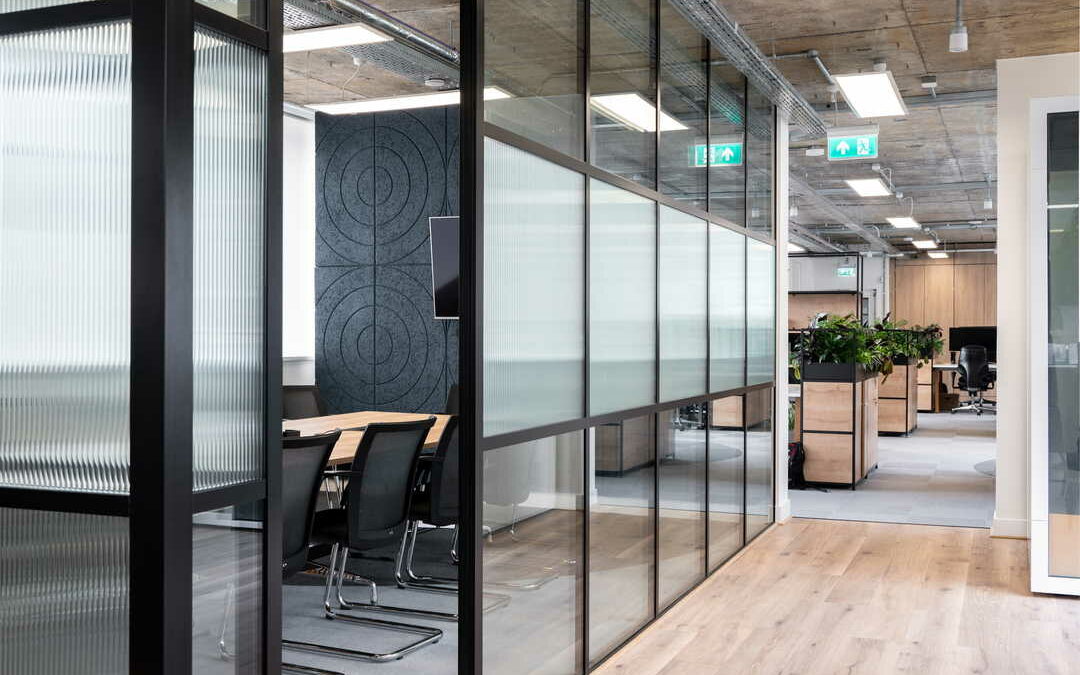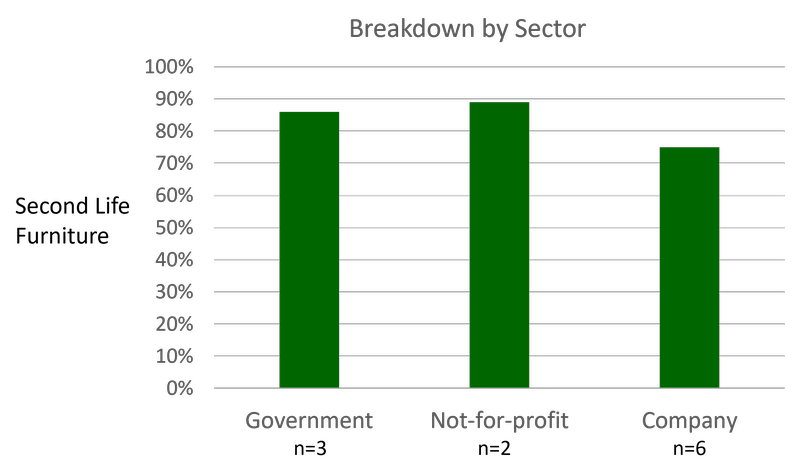Executive Summary
Having launched the Second Life Furniture mark in 2023, the Office Furniture Remanufacturing Association is pleased to report the results from the first 11 projects using the mark:
- All projects achieved at least 60% second life furniture with a substantial reduction in carbon emissions and waste.
- Cost savings were reported for all except one project, which was higher because higher spec furniture was selected – meaning that it too would have provided cost savings on a like-for-like basis.
- All projects are attractive; no compromise in aesthetics was reported or observed.
- No relationship between gross floor area and percentage second life furniture was found, within the 2,000 square foot to 100,000 square foot range of the projects.
- The sector procuring the furniture had no impact on the percentage second life furntiure used.
- Similarly, the location of projects had no statistical relationship with the percent second life furniture.
These results show that organisations can aim for at least 60% second life furniture, confident that in doing so they will save money and achieve an attractive aesthetic regardless of the location or size of the space.
Introduction
The Second Life Furniture mark was established in 2023 by the Office Furniture Remanufacturing Association with no cost to use. Its intention is to increase transparency around the redeployment of office furniture in the light of the high carbon emissions created by new offic furniture and the large volumes of office furniture sent to landfill.
This report compiles and analyses the data and observations from the first 11 projects to use the mark and submit their results to OFRA.
What is Second Life Furniture?
OFRA has set out its guidelines for how to calculate the percentage of second life furniture used in a project at https://ofrauk.org/mark/.
It includes furniture that is reused, refurbished and remanufactured – all of which create significant environmental and cost savings.
The furniture itself can come from an organisation’s existing furniture (e.g. old offices or storage) or be externally sourced from the market, provided it has had a previous life serving its same purpose as intended (i.e. furniture). Remanufacturing is permitted to bring the furniture back to as-new condition. Furniture primarily made with recycled materials is not counted because recycling breaks down materials to a molecular level and then reconstitutes them, requiring casting, shaping, surfacing, etc – which are emissions-intensive activities that, together, do not substantially reduce the carbon emissions of the finished item.
Methodology
Organisations using the second life mark are required to submit their calculations and observations. This provides a database of 11 projects to date, which has been analysed to identify patterns of adoption. 10 of the projects were offices and one was a café with meeting rooms and breakout areas. The amount of furniture sourced internally varied from none, in the case of new-build projects like 90 Blackfriars Road and the Good Company Café, to 51% for 20 Water Street, and even higher for UKGBC HQ.
Figure 1: List of Projects Using Second Life Furniture Mark
Project
2nd Life Furniture
Gross Internal Area
Location
60% Second Life Achieved by All Projects
All of the 11 projects reported over 60% second life furniture use, with one project achieving 100%. This suggests that 60% is a reasonable minimum target for organisations to aim for with their furniture.
Cost Savings and Other Benefits for All Projects
Most projects reported cost savings on a like-for-like basis. On three projects, the saving was quantified at approximately £300,000 per project. Only one project reported a higher cost than new furniture, but noted that it specified some premium bespoke items made from post-consumer waste yoghurt pots that were not included in the new furniture prices. This indicates that this project would also have achieved cost savings on a like-for-like basis.
Other benefits of using second life furniture were reported:
-
- 60% to 80% reduction in carbon emissions
- Avoided waste to landfill (and associated disposal costs) through furniture redeployment
- Reduced/eliminated Volatile Organic Compounds because off-gassing had already occurred in the first life of furniture
- Future cost and carbon emission savings because the furniture can be remanufactured multiple times further lives.
- All projects achieved a high-quality aesthetic (as can be seen from the case studies -links available in Figure 1), with a number of the projects receiving industry awards. No compromise in aesthetics due to the use of second life furniture was observed or reported.
Project Size Unrelated to Second Life Adoption
Figure 2 shows that for projects between 2,000 square feet and 100,000 square feet (the range covered by the projects) there is no relationship between size of project and percentage second life furniture.
Figure 2: Graph of Percentage Second Life Furniture Versus Gross Internal Floor Area

Sector Unrelated to Second Life Adoption
Figure 3 plots the relationship between the sector in which the project client operates against the second life furniture adoption. Given the small sample size, there does not appear to be a significant difference.
Figure 3: Impact of Sector on Second Life Furniture Percentage
Conclusions
These projects suggest that specifying a high percentage of second life furniture should save money, reduce carbon emissions, reduce waste, and achieve a high aesthetic standard, irrespective of the location, sector or size of the space.
A benchmark of at least 60% second life furniture should be achievable for all projects.
Further Information
For more information, please contact OFRA General Secretary Dr Greg Lavery at greg@rypeoffice.com.



